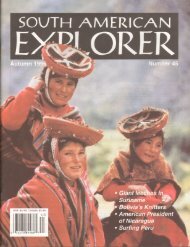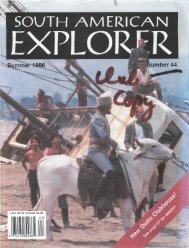Number 30 - South American Explorers
Number 30 - South American Explorers
Number 30 - South American Explorers
You also want an ePaper? Increase the reach of your titles
YUMPU automatically turns print PDFs into web optimized ePapers that Google loves.
16 SOUTH AMERICAN EXPLORER<br />
no written records of the people of pre-Colombian<br />
<strong>South</strong> America. Even if there were, chances are the<br />
questions we would ask would find no answers. All we<br />
have is their art—their statement of beliefs and values—up<br />
to us to read if we can . Trying to read it<br />
provides many delightful Hours for those hooked on<br />
pre-Colombian Art.<br />
rcheology helps. The careful methods<br />
used by archaeologists as they open<br />
trenches to recover evidence of the<br />
lives of ancient peoples have clarified<br />
many unknowns at out early man in the<br />
Americas. But the evidence brougnt to light raises additional<br />
questions. Our increasing understanding usually<br />
keeps uneasy step with a growing awareness of our<br />
own ignorance.<br />
Colombia is unusually fortunate to have several<br />
prominent archaeologists willing to consider contemporary<br />
Indian sources and what is called ethnographic<br />
material to supplement excavation data. This doesn't<br />
happen too often' in archeology. Many professionals are<br />
not open to possibilities of interpretation other than<br />
"plain dirt archeology," although this is changing.<br />
It is clear, however, that native shamanistic, mythological,<br />
and religious references, both contemporary<br />
and colonial, have much to contribute to the interpretation<br />
of the cultural, meaning of pre-Colombian Art.<br />
And, there has been enough scientific investigation in<br />
Colombia to confirm its astonishingly rich diversity of<br />
peoples and cultures during its hundreds, even thousands,<br />
of years of history.<br />
Still, it may come as a surprise that the oldest ceramics<br />
found in the western hemisphere come from Colombia<br />
and Ecuador. These date back to 3,500-3,900 B.C.,<br />
depending on which scholar's chnnology you accept.<br />
Colombia and Ecuador? What unlikely places, especially<br />
since most of the academic community has stoutly<br />
maintained for the last half-century that early man arrived<br />
in the Americas by following animal herds across<br />
the ice or over a land bridge which once stretched across<br />
the Bering Straits. (There is not enough evidence to<br />
convince scholars that Pacific crossings were made.)<br />
So, how did early man penetrate into the coastal<br />
areas of <strong>South</strong> America without leaving some tangible<br />
trail of his passing on the way? The answer to this<br />
question has sent anthropologists and others off on a<br />
grand scramble. Part of the answer might lie in rising sea<br />
levels which flooded and erased ancient campsites on<br />
the shores of North America. Then too, ice sheets may<br />
have destroyed the traces. Other scholars theorize that<br />
hunters crossed the narrow strips of land in Central<br />
America and from there followed the river systems of<br />
both continents. Of course, we may simply not have<br />
found their trail yet.<br />
It is generally believed that by 7,000 B.C. man in the<br />
Americas gradually abandoned hunting and gathering<br />
and settled down, relying for sustenance more on shellfish,<br />
plants, and small animals in localized areas. When<br />
man learned to make fire-hardened clay vessels for<br />
cooking and storage, he overcame a major cause of<br />
hunger and want. From then on, he left an indelible trail<br />
of refuse heaps, graves, and food caches for the archaeologist<br />
to follow, an enduring trail of broken pottery,<br />
shards dear to the hearts of all students of early history.<br />
Ceramics, precious from the very beginning, were<br />
found in graves with the most cherished possessions of<br />
the people. As potting and modeling improved, craftsmen<br />
pictured themselves and their deities in clay. We<br />
look at these creations today with amazement, speculating<br />
on symbols and subject matter, admiring the skill<br />
and the sophisticated artistry of many of the pieces.<br />
Some, of course, are better than others. Quality is uneven.<br />
We can't be sure when art'production became<br />
specialized in early communities, but it must have been<br />
obvious from the start that some people were better at<br />
it than others. Specialization probably set in fairly early<br />
with artists trading their work for food or weapons. A<br />
few created masterpieces, and these are what we will see<br />
in a museum if we are lucky—or the museum is. Masterpieces<br />
in pre-Colombian art are as rare as masterpieces<br />
in other kinds of art. There just aren't very many,<br />
although there are numerous examples of good art and<br />
very fine pieces do turn up occasionally.<br />
Pre-Colombian art in our day is finally coming into<br />
its own—viewed as an art form rather than a craft of<br />
only anthropological interest. Part of this change in<br />
attitude comes from exposure. There are more pieces<br />
to look at now, more books to read, more articles written,<br />
and more travellers to <strong>South</strong> America where there<br />
is growing pride among the people in their heritage.<br />
I have a friend Nancy, in Houston, who occasionally<br />
comes to visit. When I take her around the pre-Colom-<br />
RIGHT, Quimbaya two-faced urn lid, A.D. 1200-1500,<br />
Magdalena River Valley, Colombia. Gift of Mr. & Mrs.<br />
Cedric Marks to the Denver Art Museum.





